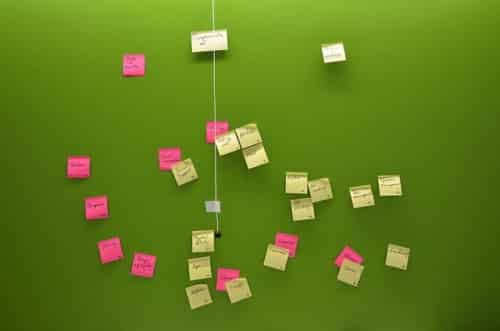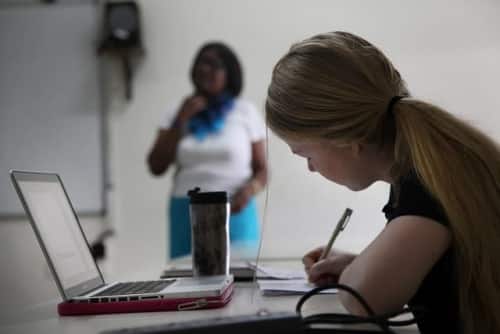Table of Contents
Make the most of students’ summer experiences with back-to-school activity  by Tanner Higgin
by Tanner Higgin
Every teacher preps for the summer slide, the three-month drain of some of last school year’s learning. In fact, you probably have some tried-and-true assessment and refresher strategies aimed at figuring out where your students are and how to get them up to speed. The summer slide is just one of the many challenges teachers tackle come back-to-school time.
But is the summer slide really all that bad? I don’t think so; in fact, I think the summer slide can be pretty great. Think about it this way: Much of the stuff students are doing over the summer is full of informal, experiential, personally chosen learning — it just doesn’t look like school.
To embrace the summer slide and turn it into September success, all you need to do is think of it as interest-driven learning, not wasted time. Use what kids choose to do over the summer to find out what’ll engage your students during the semester.
To embrace the summer slide and turn it into September success, all you need to do is think of it as interest-driven learning, not wasted time.
Check out the below activity, which gets students to reflect on what they did over the summer and then design introductory projects that connect their experiences to your curriculum.
Mind Mapping: What’d You Do Over the Summer?
 Use a mind-mapping tool, such as Popplet, to get students thinking freely and quickly jotting down things they did, from events to activities, sports, movies, and beyond. Once they’ve got a lot of ideas gathered, see if they can note the relative significance of each node of their mind map and then cluster them to identify trends. The big key here is for students to be unfiltered.
Use a mind-mapping tool, such as Popplet, to get students thinking freely and quickly jotting down things they did, from events to activities, sports, movies, and beyond. Once they’ve got a lot of ideas gathered, see if they can note the relative significance of each node of their mind map and then cluster them to identify trends. The big key here is for students to be unfiltered.
Once the mind maps are complete, work with students to attach learning outcomes. For instance, a student who watched a lot of movies may have learned something about herself or the world without fully realizing it; a student who just got a smartphone may have taken a picture he’s proud of or made a great joke on social media. In this phase, the important thing is to show students how learning is a part of everything they do.
Reflection: What Do You Still Want to Know?
 The goal now is to work with students to develop a plan for how to continue this informal learning in your classroom. Using a feedback tool such as Formative, NowComment, or Kaizena, ask students to develop questions they’d like to pursue answers to and offer guidance. Help them refine the questions, connect the questions to your curriculum, and work together to formulate a compelling project that develops direct connections to what they did over the summer.
The goal now is to work with students to develop a plan for how to continue this informal learning in your classroom. Using a feedback tool such as Formative, NowComment, or Kaizena, ask students to develop questions they’d like to pursue answers to and offer guidance. Help them refine the questions, connect the questions to your curriculum, and work together to formulate a compelling project that develops direct connections to what they did over the summer.
Planning: How Do You Plan to Find Out More?
Students should now have the most important part of any project-based learning (PBL) experience: a driving question tied to their interests (and your curriculum). The challenge now is helping them see the projects through. There are a bunch of great tools to document, organize, and assess work. These tools -– from those built for learning such as Seesaw or Pathbrite to those not, such as Tackk and WordPress –- accomplish two essential goals of interest-driven PBL: 1). They put the focus on the formative process of learning over the summative end product, and 2). They allow students to share their work with a larger community. Get students up and going on one or a couple of these options, and set up a regular schedule to share progress, get feedback, and present their results.
These are, of course, just suggestions, and I admit they leave out a lot of the nitty-gritty details that make PBL challenging. I think the challenge is worth it, though. Digging into students’ interests right off the bat hooks students and shows them they’re in for a year of truly being in the driver’s seat. Most importantly, it flips the negative summer-slide rhetoric on its head, viewing students less as brains drained of knowledge and more as thriving gardens of experience.
“DSC_0118” by Doblin/Monitor. Used under CC BY-NC 2.0 license.
“Amelia works on a problem in Math HL (Hyderabad, India)” by THINK Global School. User under CC BY-NC-ND 2.0 license.
This piece originally appeared on Common Sense Education.
 Tanner Higgin is Director, Education Editorial Strategy at Common Sense Education where he leads the editorial team responsible for edtech reviews and resources. Previously, he taught writing and media literacy for six years, and has a Ph.D. from the University of California, Riverside. His research on video games and culture has been published in journals, books, and online, presented at conferences nationwide, and continues to be cited and taught in classes around the world.
Tanner Higgin is Director, Education Editorial Strategy at Common Sense Education where he leads the editorial team responsible for edtech reviews and resources. Previously, he taught writing and media literacy for six years, and has a Ph.D. from the University of California, Riverside. His research on video games and culture has been published in journals, books, and online, presented at conferences nationwide, and continues to be cited and taught in classes around the world.
Prior to joining Common Sense Education, Tanner worked as a curriculum developer and researcher at GameDesk, helping to design and launch Educade.org and the PlayMaker School. While at GameDesk, he co-designed the United Colonies alternate reality game (ARG) with Mike Minadeo. This ARG is to date one of the most sophisticated to be implemented in a K-12 environment. Outside of education, Tanner has been a Technical Writer-Editor for the Department of Defense, a web designer, and co-editor and co-creator of a print literary journal.
Follow Tanner Higgin on Twitter
Further Reading
- eSchool News – ISTE 2018 emphasizes AI in classrooms
- Forbes – How Back-To-School Stress Is Different In 2018
- The Advocate – It’s back-to-school time: What would you tell your younger self, all these years later?
